jump start SUBARU CROSSTREK 2017 1.G Owners Manual
[x] Cancel search | Manufacturer: SUBARU, Model Year: 2017, Model line: CROSSTREK, Model: SUBARU CROSSTREK 2017 1.GPages: 572, PDF Size: 41.52 MB
Page 159 of 572
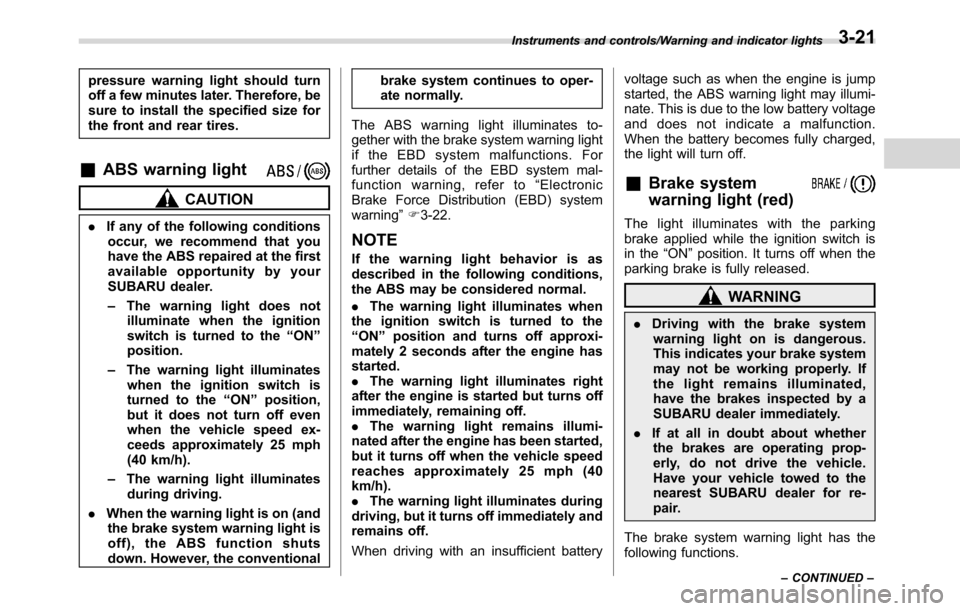
pressure warning light should turn
off a few minutes later. Therefore, be
sure to install the specified size for
the front and rear tires.
&ABS warning light
CAUTION
.If any of the following conditions
occur, we recommend that you
have the ABS repaired at the first
available opportunity by your
SUBARU dealer.
–The warning light does not
illuminate when the ignition
switch is turned to the“ON”
position.
–The warning light illuminates
when the ignition switch is
turned to the“ON”position,
but it does not turn off even
when the vehicle speed ex-
ceeds approximately 25 mph
(40 km/h).
–The warning light illuminates
during driving.
.When the warning light is on (and
the brake system warning light is
off), the ABS function shuts
down. However, the conventionalbrake system continues to oper-
ate normally.
The ABS warning light illuminates to-
gether with the brake system warning light
if the EBD system malfunctions. For
further details of the EBD system mal-
function warning, refer to“Electronic
Brake Force Distribution (EBD) system
warning”F3-22.NOTE
If the warning light behavior is as
described in the following conditions,
the ABS may be considered normal.
.The warning light illuminates when
the ignition switch is turned to the
“ON”position and turns off approxi-
mately 2 seconds after the engine has
started.
.The warning light illuminates right
after the engine is started but turns off
immediately, remaining off.
.The warning light remains illumi-
nated after the engine has been started,
but it turns off when the vehicle speed
reaches approximately 25 mph (40
km/h).
.The warning light illuminates during
driving, but it turns off immediately and
remains off.
When driving with an insufficient batteryvoltage such as when the engine is jump
started, the ABS warning light may illumi-
nate. This is due to the low battery voltage
and does not indicate a malfunction.
When the battery becomes fully charged,
the light will turn off.
&Brake system
warning light (red)
The light illuminates with the parking
brake applied while the ignition switch is
in the“ON”position. It turns off when the
parking brake is fully released.
WARNING
.Driving with the brake system
warning light on is dangerous.
This indicates your brake system
may not be working properly. If
the light remains illuminated,
have the brakes inspected by a
SUBARU dealer immediately.
.If at all in doubt about whether
the brakes are operating prop-
erly, do not drive the vehicle.
Have your vehicle towed to the
nearest SUBARU dealer for re-
pair.
The brake system warning light has the
following functions.
Instruments and controls/Warning and indicator lights
–CONTINUED–3-21
Page 391 of 572
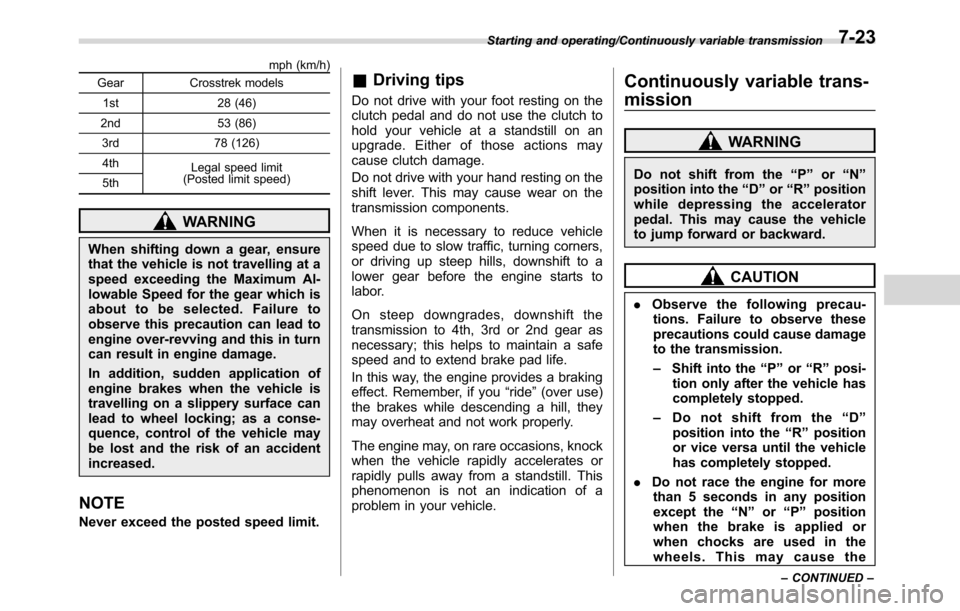
mph (km/h)
Gear Crosstrek models
1st 28 (46)
2nd 53 (86)
3rd 78 (126)
4th
Legal speed limit
(Posted limit speed)
5th
WARNING
When shifting down a gear, ensure
that the vehicle is not travelling at a
speed exceeding the Maximum Al-
lowable Speed for the gear which is
about to be selected. Failure to
observe this precaution can lead to
engine over-revving and this in turn
can result in engine damage.
In addition, sudden application of
engine brakes when the vehicle is
travelling on a slippery surface can
lead to wheel locking; as a conse-
quence, control of the vehicle may
be lost and the risk of an accident
increased.
NOTE
Never exceed the posted speed limit.
&Driving tips
Do not drive with your foot resting on the
clutch pedal and do not use the clutch to
hold your vehicle at a standstill on an
upgrade. Either of those actions may
cause clutch damage.
Do not drive with your hand resting on the
shift lever. This may cause wear on the
transmission components.
When it is necessary to reduce vehicle
speed due to slow traffic, turning corners,
or driving up steep hills, downshift to a
lower gear before the engine starts to
labor.
On steep downgrades, downshift the
transmission to 4th, 3rd or 2nd gear as
necessary; this helps to maintain a safe
speed and to extend brake pad life.
In this way, the engine provides a braking
effect. Remember, if you“ride”(over use)
the brakes while descending a hill, they
may overheat and not work properly.
The engine may, on rare occasions, knock
when the vehicle rapidly accelerates or
rapidly pulls away from a standstill. This
phenomenon is not an indication of a
problem in your vehicle.
Continuously variable trans-
mission
WARNING
Do not shift from the“P”or“N”
position into the“D”or“R”position
while depressing the accelerator
pedal. This may cause the vehicle
to jump forward or backward.
CAUTION
.Observe the following precau-
tions. Failure to observe these
precautions could cause damage
to the transmission.
–Shift into the“P”or“R”posi-
tion only after the vehicle has
completely stopped.
–Do not shift from the“D”
position into the“R”position
or vice versa until the vehicle
has completely stopped.
.Do not race the engine for more
than 5 seconds in any position
except the“N”or“P”position
when the brake is applied or
when chocks are used in the
wheels. This may cause the
Starting and operating/Continuously variable transmission
–CONTINUED–7-23
Page 434 of 572
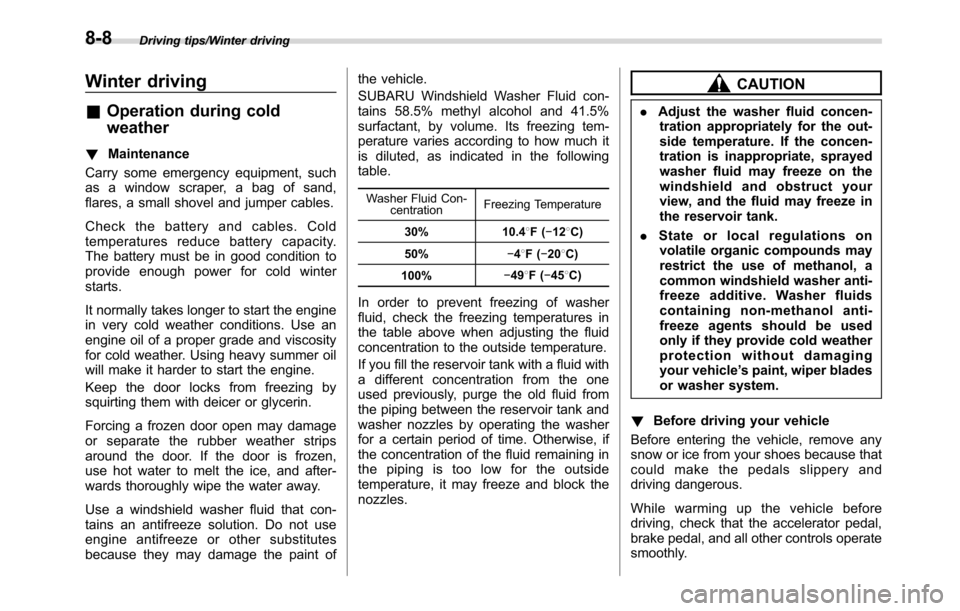
Driving tips/Winter driving
Winter driving
&Operation during cold
weather
!Maintenance
Carry some emergency equipment, such
as a window scraper, a bag of sand,
flares, a small shovel and jumper cables.
Check the battery and cables. Cold
temperatures reduce battery capacity.
The battery must be in good condition to
provide enough power for cold winter
starts.
It normally takes longer to start the engine
in very cold weather conditions. Use an
engine oil of a proper grade and viscosity
for cold weather. Using heavy summer oil
will make it harder to start the engine.
Keep the door locks from freezing by
squirting them with deicer or glycerin.
Forcing a frozen door open may damage
or separate the rubber weather strips
around the door. If the door is frozen,
use hot water to melt the ice, and after-
wards thoroughly wipe the water away.
Use a windshield washer fluid that con-
tains an antifreeze solution. Do not use
engine antifreeze or other substitutes
because they may damage the paint ofthe vehicle.
SUBARU Windshield Washer Fluid con-
tains 58.5% methyl alcohol and 41.5%
surfactant, by volume. Its freezing tem-
perature varies according to how much it
is diluted, as indicated in the following
table.
Washer Fluid Con-
centrationFreezing Temperature
30% 10.48F(−128C)
50%−48F(−208C)
100%−498F(−458C)
In order to prevent freezing of washer
fluid, check the freezing temperatures in
the table above when adjusting the fluid
concentration to the outside temperature.
If you fill the reservoir tank with a fluid with
a different concentration from the one
used previously, purge the old fluid from
the piping between the reservoir tank and
washer nozzles by operating the washer
for a certain period of time. Otherwise, if
the concentration of the fluid remaining in
the piping is too low for the outside
temperature, it may freeze and block the
nozzles.
CAUTION
.Adjust the washer fluid concen-
tration appropriately for the out-
side temperature. If the concen-
tration is inappropriate, sprayed
washer fluid may freeze on the
windshield and obstruct your
view, and the fluid may freeze in
the reservoir tank.
.State or local regulations on
volatile organic compounds may
restrict the use of methanol, a
common windshield washer anti-
freeze additive. Washer fluids
containing non-methanol anti-
freeze agents should be used
only if they provide cold weather
protection without damaging
your vehicle’s paint, wiper blades
or washer system.
!Before driving your vehicle
Before entering the vehicle, remove any
snow or ice from your shoes because that
could make the pedals slippery and
driving dangerous.
While warming up the vehicle before
driving, check that the accelerator pedal,
brake pedal, and all other controls operate
smoothly.
8-8
Page 453 of 572
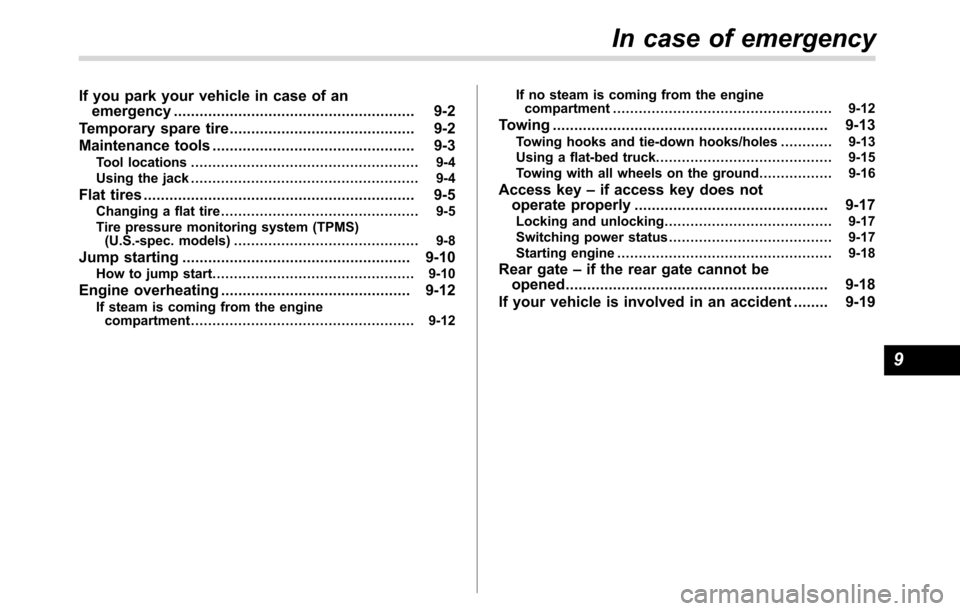
If you park your vehicle in case of an
emergency........................................................ 9-2
Temporary spare tire........................................... 9-2
Maintenance tools............................................... 9-3
Tool locations..................................................... 9-4
Using the jack..................................................... 9-4
Flat tires............................................................... 9-5Changing a flat tire.............................................. 9-5
Tire pressure monitoring system (TPMS)
(U.S.-spec. models)........................................... 9-8
Jump starting..................................................... 9-10How to jump start............................................... 9-10
Engine overheating............................................ 9-12
If steam is coming from the engine
compartment.................................................... 9-12If no steam is coming from the engine
compartment................................................... 9-12
Towing................................................................ 9-13Towing hooks and tie-down hooks/holes............ 9-13
Using a flat-bed truck......................................... 9-15
Towing with all wheels on the ground................. 9-16
Access key–if access key does not
operate properly............................................. 9-17
Locking and unlocking....................................... 9-17
Switching power status...................................... 9-17
Starting engine.................................................. 9-18
Rear gate–if the rear gate cannot be
opened............................................................. 9-18
If your vehicle is involved in an accident........ 9-19
In case of emergency
9
Page 462 of 572
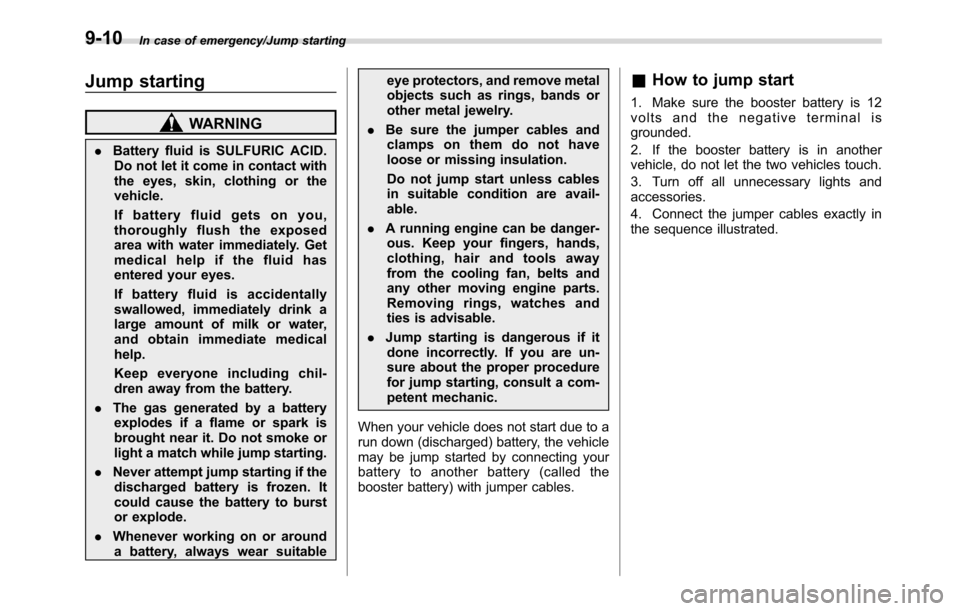
In case of emergency/Jump starting
Jump starting
WARNING
.Battery fluid is SULFURIC ACID.
Do not let it come in contact with
the eyes, skin, clothing or the
vehicle.
If battery fluid gets on you,
thoroughly flush the exposed
area with water immediately. Get
medical help if the fluid has
entered your eyes.
If battery fluid is accidentally
swallowed, immediately drink a
large amount of milk or water,
and obtain immediate medical
help.
Keep everyone including chil-
dren away from the battery.
.The gas generated by a battery
explodes if a flame or spark is
brought near it. Do not smoke or
light a match while jump starting.
.Never attempt jump starting if the
discharged battery is frozen. It
could cause the battery to burst
or explode.
.Whenever working on or around
a battery, always wear suitableeye protectors, and remove metal
objects such as rings, bands or
other metal jewelry.
.Be sure the jumper cables and
clamps on them do not have
loose or missing insulation.
Do not jump start unless cables
in suitable condition are avail-
able.
.A running engine can be danger-
ous. Keep your fingers, hands,
clothing, hair and tools away
from the cooling fan, belts and
any other moving engine parts.
Removing rings, watches and
ties is advisable.
.Jump starting is dangerous if it
done incorrectly. If you are un-
sure about the proper procedure
for jump starting, consult a com-
petent mechanic.
When your vehicle does not start due to a
run down (discharged) battery, the vehicle
may be jump started by connecting your
battery to another battery (called the
booster battery) with jumper cables.
&How to jump start
1. Make sure the booster battery is 12
volts and the negative terminal is
grounded.
2. If the booster battery is in another
vehicle, do not let the two vehicles touch.
3. Turn off all unnecessary lights and
accessories.
4. Connect the jumper cables exactly in
the sequence illustrated.
9-10
Page 463 of 572
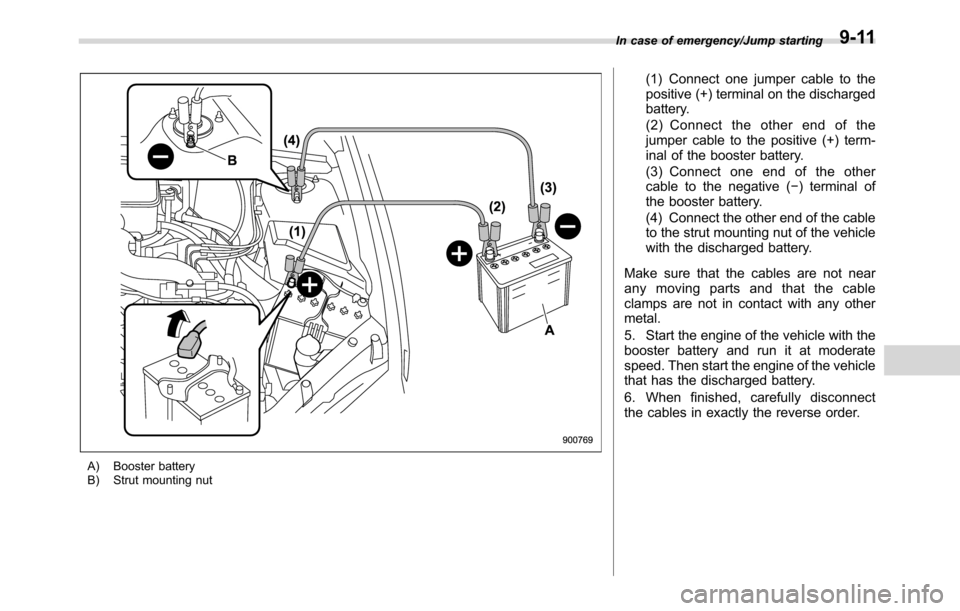
A) Booster battery
B) Strut mounting nut
(1) Connect one jumper cable to the
positive (+) terminal on the discharged
battery.
(2) Connect the other end of the
jumper cable to the positive (+) term-
inal of the booster battery.
(3) Connect one end of the other
cable to the negative (−) terminal of
the booster battery.
(4) Connect the other end of the cable
to the strut mounting nut of the vehicle
with the discharged battery.
Make sure that the cables are not near
any moving parts and that the cable
clamps are not in contact with any other
metal.
5. Start the engine of the vehicle with the
booster battery and run it at moderate
speed. Then start the engine of the vehicle
that has the discharged battery.
6. When finished, carefully disconnect
the cables in exactly the reverse order.
In case of emergency/Jump starting9-11
Page 558 of 572

14-2Index
A
Abbreviation................................................................... 3
ABS (Anti-lock Brake System)..................................... 7-32
Warning light......................................................... 3-21
Access key................................................................. 2-9
Warning indicator................................................... 3-25
Accessories.............................................................. 11-36
Accessory power outlet................................................. 6-8
Air cleaner element................................................... 11-12
Air conditioner
Automatic climate control.......................................... 4-7
Manual climate control.............................................. 4-8
Air filtration system..................................................... 4-12
Air flow mode.............................................................. 4-8
Alarm system............................................................ 2-26
All-Wheel Drive warning light....................................... 3-23
Aluminum wheel....................................................... 11-28
Cleaning............................................................... 10-3
Antenna...................................................................... 5-2
Anti-lock Brake System (ABS)..................................... 7-32
Arming the system..................................................... 2-27
Armrest....................................................................... 1-8
Ashtray..................................................................... 6-10
AT OIL TEMP warning light......................................... 3-19
Audio
aha
TMby HARMAN................................................ 5-43
AM/FM radio......................................................... 5-28
AUX ..................................................................... 5-60
Base display audio set.............................................. 5-4
Basic operation...................................................... 5-18
Bluetooth audio...................................................... 5-57CD ....................................................................... 5-52
iPod...................................................................... 5-55
Pandora
®.............................................................. 5-49
SiriusXM Satellite Radio.......................................... 5-37
STARLINK
TM7.0 Multimedia Plus audio set................ 5-6
Steering switches for audio...................................... 5-62
SUBARU STARLINK............................................... 5-26
Unit setting............................................................ 5-19
USB memory......................................................... 5-54
Auto on/off headlights................................................. 3-89
Automatic headlight beam leveler................................. 3-93
Warning light.......................................................... 3-31
Automatic Locking Retractor/Emergency Locking
Retractor (ALR/ELR)................................................ 1-12
B
Battery
Drainage prevention function..................................... 2-7
Jump starting......................................................... 9-10
Replacement (access key)..................................... 11-42
Replacement (transmitter)...................................... 11-43
Vehicle battery..................................................... 11-33
Bluetooth
®
Audio.................................................................... 5-57
Hands-free phone system........................................ 5-70
Settings................................................................. 5-65
Troubleshooting...................................................... 5-88
Bluetooth
®settings..................................................... 5-65
Booster seat.............................................................. 1-31
Bottle holder............................................................... 6-7
Page 562 of 572
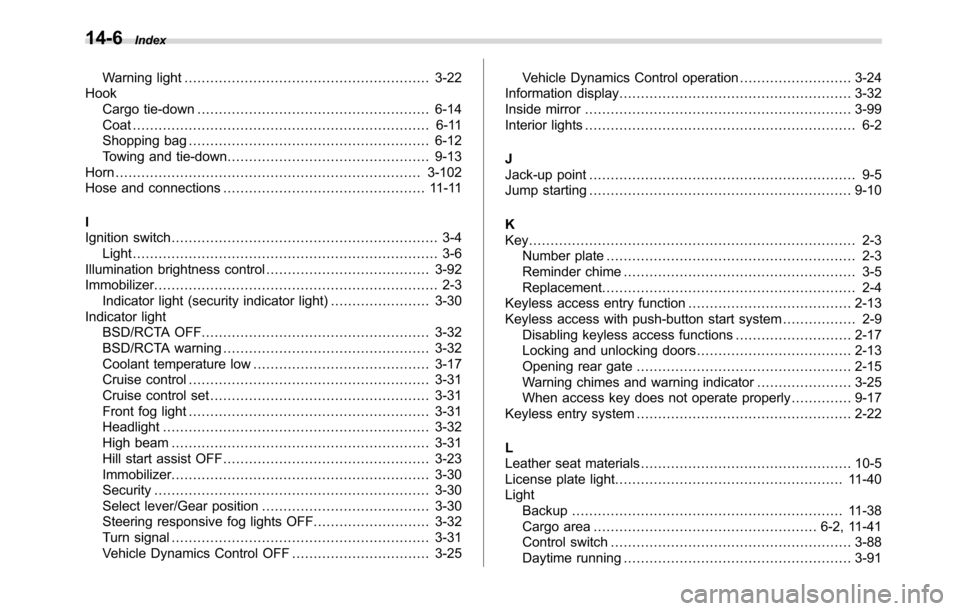
14-6Index
Warning light......................................................... 3-22
Hook
Cargo tie-down...................................................... 6-14
Coat..................................................................... 6-11
Shopping bag........................................................ 6-12
Towing and tie-down............................................... 9-13
Horn....................................................................... 3-102
Hose and connections............................................... 11-11
I
Ignition switch.............................................................. 3-4
Light....................................................................... 3-6
Illumination brightness control...................................... 3-92
Immobilizer.................................................................. 2-3
Indicator light (security indicator light)....................... 3-30
Indicator light
BSD/RCTA OFF..................................................... 3-32
BSD/RCTA warning................................................ 3-32
Coolant temperature low......................................... 3-17
Cruise control........................................................ 3-31
Cruise control set................................................... 3-31
Front fog light........................................................ 3-31
Headlight.............................................................. 3-32
High beam............................................................ 3-31
Hill start assist OFF................................................ 3-23
Immobilizer............................................................ 3-30
Security................................................................ 3-30
Select lever/Gear position....................................... 3-30
Steering responsive fog lights OFF........................... 3-32
Turn signal............................................................ 3-31
Vehicle Dynamics Control OFF................................ 3-25Vehicle Dynamics Control operation .......................... 3-24
Information display...................................................... 3-32
Inside mirror.............................................................. 3-99
Interior lights............................................................... 6-2
J
Jack-up point.............................................................. 9-5
Jump starting............................................................. 9-10
K
Key............................................................................ 2-3
Number plate.......................................................... 2-3
Reminder chime...................................................... 3-5
Replacement........................................................... 2-4
Keyless access entry function...................................... 2-13
Keyless access with push-button start system................. 2-9
Disabling keyless access functions........................... 2-17
Locking and unlocking doors.................................... 2-13
Opening rear gate.................................................. 2-15
Warning chimes and warning indicator...................... 3-25
When access key does not operate properly.............. 9-17
Keyless entry system.................................................. 2-22
L
Leather seat materials................................................. 10-5
License plate light..................................................... 11-40
Light
Backup
............................................................... 11-38
Cargo area.................................................... 6-2, 11-41
Control switch........................................................ 3-88
Daytime running..................................................... 3-91